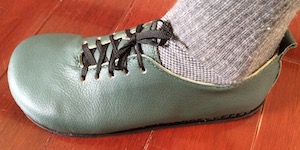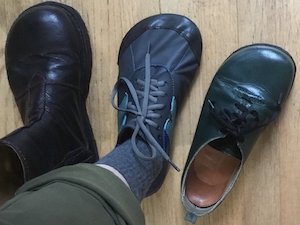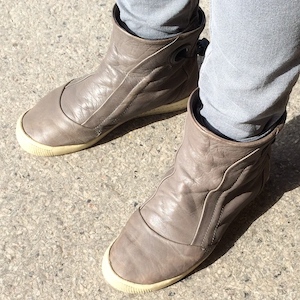About tozafoot

A lasted lace-up with a single welt I made myself in 2016: no raised heel and lots of toe room.
Find me on social media: on Mastodon (I update there more frequently than I do this site).
I started making my own shoes and boots in 2015, because:
- My big toe joints had started hurting with every step whenever I was wearing any kind of footwear, including conventional socks!
- My feet were pain free when I went barefoot; I realized that several characteristics (tapering toes, raised heels, stiff soles, and toe spring) of almost all commercially-available footwear were seriously damaging my feet.
- I couldn’t buy what I needed. The very few pairs that didn’t instantly cause pain when I put them on didn’t fit, were impractical for what I needed, or were downright hideous to look at.
Because I couldn’t buy footwear to suit, the only thing to do was to make my own. I bought some books, and took a couple of short, intensive shoemaking courses.
Since then, I have made many blissfully comfortable pairs of shoes, boots and sandals to my own designs.
In more recent years, more companies have been selling foot-shaped shoes with flat, flexible soles. I have tried some of these, with varying success. My favorites to date are the Primal and Wide styles from SoftStar Shoes, and now I often wear either the Hawthorne Chukka or Rogue styles in Wide.

The shape of the shoes and boots I made myself (left, right) are almost identical to the "Primal" and Wide shapes of footwear now being sold by SoftStar Shoes (their Primal RunAmoc is in the center). They hadn't introduced any Primal or Wide styles when I first started making footwear, but they now offer several.
Shape matters
The shape of the shoes I make reflects the shape and movement of my feet. Most store-bought shoes do not.
Almost all modern mass-produced shoes are deforming people’s feet, and most of us don’t realize until it’s too late.
The pain I’d been experiencing arose from the footwear I had been wearing; it was not intrinsic to my feet.
Changing my footwear made the pain disappear.
Free toes
My shoes and boots now all have a roomy toe area. This is crucial in completely eliminating the debilitating foot pain I had been experiencing.
My toe and forefoot joints can now move as nature intended them to: my toes stay aligned with the relevant bones in the mid part of my foot, whether I am standing or moving. The incipient bunions I was developing have almost disappeared.
Completely flat, flexible sole

A pair of ankle boots made by someone else. Note the toe shape: tapering pretty much symmetrically towards the center-line of the foot. This forces the big toe out of its natural alignment and squashes all the toes together. Also note the raised heel, which puts more weight through the squashed forefoot. Footwear with this shape hurts my toes!
I want my feet to be functional and pain-free my whole life, so I have completely done away with heels.
Elevating the heel puts extra stress on the front of the foot, especially on the joints at the base of each toe.
Forefoot joints carry more weight in heeled shoes than they do when barefoot, whether standing, walking or running. This extra weight eventually exerts a toll on the joints. Eliminate the heel, reduce the load on the joints.
Foot-shaped
My shoes are asymmetrical and flat, reflecting the shape of the foot.
Consequently, patterns for making my shoes are different on the inside than the outside of the foot.
Designing and assembling highly asymmetrical patterns can take longer and be more expensive than making patterns for shoes that are more-or-less symmetrical down the center line of the foot... Are we surprised that most commercial footwear goes for the cheaper option?
Change to "barefoot" shoes stopped pain without painkillers or surgery
When I consulted a podiatrist about my excruciating toe joint pain, she told me I had arthritis in the joint. She said I would likely need to take painkillers daily for extended periods, and that eventually I would need surgery on the joint. Oh, and by the way, I was getting bunions.
I was shocked at the idea of having to live with chronic pain, and needing serious medical intervention to fix it. So I decided to research the issue and see if I could come up with another solution.
To cut a long story short, my feet are pain-free now that I am only wearing shoes which have an asymmetric shape with roomy toes and flat, flexible soles. No medications. No surgery. And no bunions. Just letting the foot move as naturally as possible.
Note: you don't have to take my word for the benefits of the kinds of footwear I enthuse about. The Natural Footgear blog covers a lot of the relevant research.
Disclaimer
I am not a medical professional and nothing on this site is intended to be medical advice. Before transitioning to minimalist, zero-drop footwear you should consult an appropriate medical practitioner.